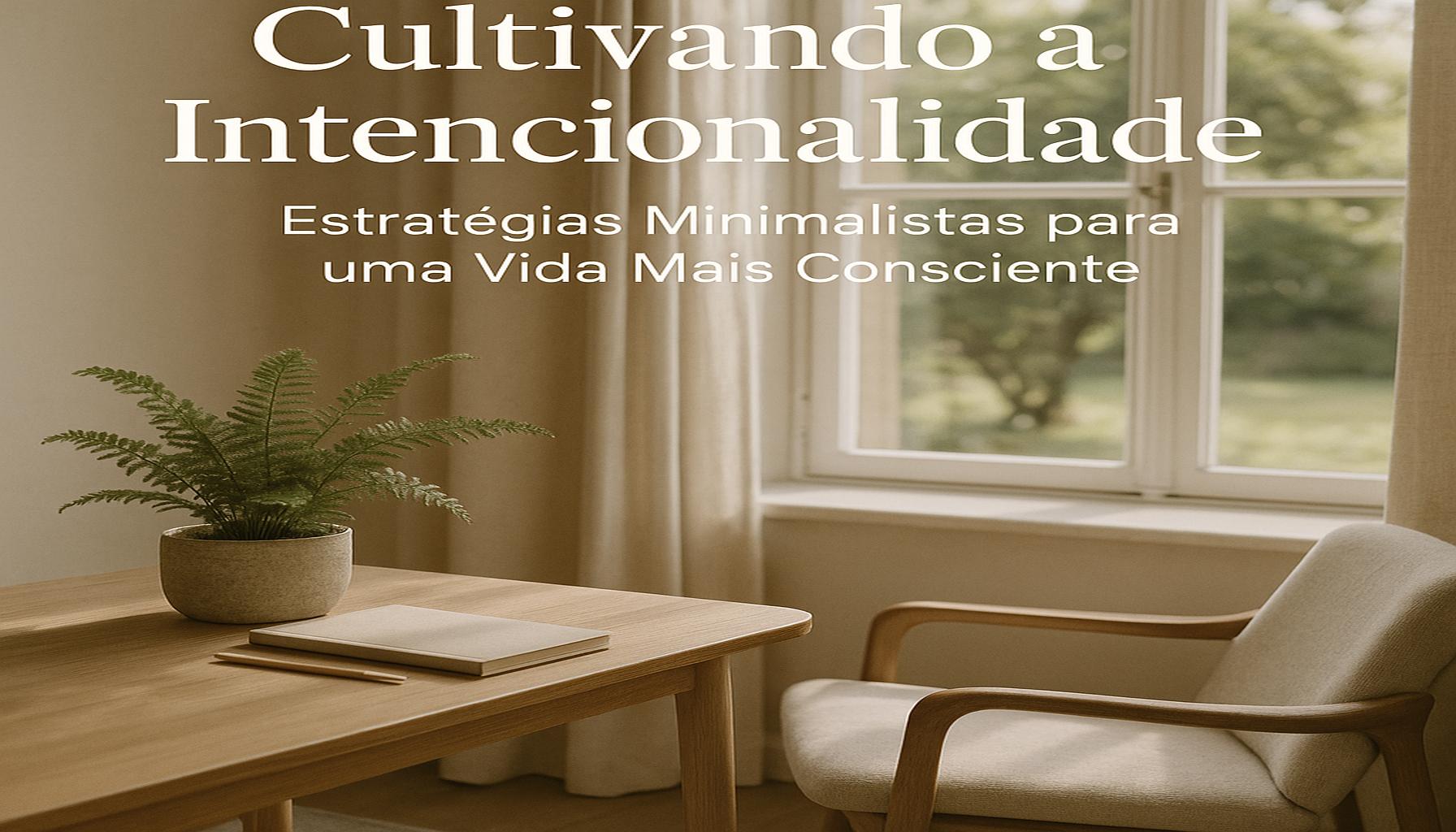Cultivating Intentionality: Minimalist Strategies for a More Conscious Life

Understanding the Need for Conscious Living
In a world characterized by constant change and a relentless pursuit of material gain, many individuals are beginning to feel the weight of their possessions and commitments. The obsession with accumulating more—be it physical items, tasks, or digital distractions—can cloud our judgment and inhibit our ability to appreciate the moment. To counteract this overwhelming sensation, we can turn to intentional living, which emphasizes a focus on simplicity and mindfulness. By implementing minimalist strategies, we can discover what truly enriches our lives.
Defining Key Elements of a Conscious Life
At the core of intentional living are three crucial elements:
- Mindfulness: This concept involves actively engaging in the present moment rather than dwelling on the past or worrying about the future. Practicing mindfulness can take many forms, such as meditation, deep breathing exercises, or simply taking a moment to enjoy your morning coffee without distractions.
- Simplicity: Achieving simplicity means minimizing both physical and mental clutter. This can be a gradual process of decluttering your living space by donating unused items or opting for fewer, higher-quality possessions. It’s also about simplifying your schedule to eliminate unnecessary obligations that don’t align with your core values.
- Prioritization: This involves identifying what truly matters to you. What brings you joy, fulfillment, or a sense of purpose? By determining these key aspects, you can effectively allocate your time and energy toward activities that align with your values, enhancing your overall happiness.
Integrating these principles into your lifestyle offers a transformative opportunity to not just improve daily routines but also to cultivate a deeper connection to your fundamental beliefs. For instance, consider your daily technology usage. Are your digital habits enriching your life, or do they contribute to distraction and disengagement? By intentionally curating your technology use, you can create a more focused and fulfilling digital experience.
Strategies for Implementing Intentional Living
With the foundational principles established, let’s explore practical strategies to embrace intentional living:
- Decluttering Your Home: Start small by focusing on one area, such as a closet or a kitchen drawer. As you sort through items, ask yourself, “Do I use this? Does it bring me joy?” Items that don’t meet these criteria can be donated or recycled.
- Evaluating Daily Habits: Keep a journal for a week to track your daily activities. This can highlight time-wasting habits or commitments that you can reassess. Focus instead on routines that reinforce your goals and values.
- Mindful Consumption: When purchasing new items, practice intentional buying. Ask yourself if the purchase aligns with your values or if it is simply an impulse buy. This can lead to more thoughtful spending and a lighter lifestyle.
As you journey toward a more conscious life, the benefits of embracing intentional living and minimalism become increasingly evident. Beyond merely reducing material possessions, this lifestyle approach encourages personal growth, clarity, and happiness. By realigning our lives with what genuinely matters, we can uncover profound fulfillment and start living with purpose.

DISCOVER MORE: Click here to learn about the mind-clearing benefits of decluttering
Embracing Purposeful Changes
As we consider the transition toward a more intentional life, it’s essential to recognize that this journey is not just about physical decluttering; it’s also about fostering an internal shift toward greater awareness and significance. The clash between consumer culture and our innate desire for fulfillment can leave many feeling adrift. Research indicates that Americans now own an average of over 300,000 items, yet studies suggest that happiness derived from possessions is fleeting at best. This duality emphasizes the need for a movement away from mere accumulation to meaningful engagement with our surroundings and ourselves.
Creating a Mindful Environment
One of the first steps in cultivating intentionality is redesigning our living spaces to reflect our values. Our environment plays a critical role in shaping our mental clarity and emotional well-being. Implementing a more minimalist approach to home decor can lead to enhanced focus, creativity, and tranquility. Consider the following strategies to create a mindful environment:
- Natural Elements: Integrating plants into your space not only beautifies your environment but also purifies the air and enhances mood. Consider easy-to-care-for options such as succulents or snake plants, which require minimal upkeep.
- Purposeful Decor: Choose decor items that have personal significance or inspire you, rather than filling your space with trinkets purchased on a whim. Each piece should reflect who you are and contribute to a sense of peace.
- Dedicated Spaces: Establish areas in your home for specific purposes, whether it’s a reading nook for relaxation or a workspace designed for productivity. This approach helps delineate different aspects of your life, ensuring a balanced and intentional routine.
Reassessing how we interact with our physical surroundings allows us to create spaces that foster conscious living. This transformation doesn’t have to occur overnight; instead, focus on one aspect at a time, gradually inviting intentionality into every corner of your home.
Mindfulness in Daily Routines
Beyond the physical realm, intentional living must seep into our daily routines. The average American spends over 11 hours a day interacting with digital media, leaving little time for introspection or genuine connection. To cultivate a more conscious existence, consider these actionable approaches:
- Digital Detox: Schedule specific hours each week for a complete break from screens. Use this time to engage in activities that nourish your spirit, such as reading, hiking, or spending quality time with loved ones.
- Mindful Eating: Transform mealtime into an opportunity for mindfulness. Focus on the flavors, textures, and visuals of your food, while minimizing distractions like TV or smartphones during meals.
- Gratitude Journaling: Set aside a few minutes each day to reflect on what you are grateful for. This practice can help shift your mindset towards appreciation and away from stress or dissatisfaction.
As you implement these changes, the process of cultivating intentionality in your life will become more evident. Each step taken toward being more mindful and less reactive creates a ripple effect, enabling a lifestyle rich in purpose and meaning.
Cultivating Intentionality Through Minimalism
In our fast-paced lives, cultivating intentionality can sometimes feel like an overwhelming task. However, minimalism offers practical strategies to simplify this process. By focusing on the essentials and reducing distractions, you can create a life filled with purpose and clarity. Minimalism encourages you to evaluate what truly matters, leading to more fulfilled living. One effective practice is the 30-day minimalism challenge, where participants eliminate one item on the first day, two on the second, and so forth. This exercise not only declutters your space but also prompts deeper reflection on your possessions and values. Through this challenge, individuals often discover that less truly is more. It fosters a deeper appreciation for what you have, allowing for a conscious connection to your belongings. Moreover, intentional living is closely tied to mindfulness. Incorporating mindfulness techniques, such as meditation or journaling, can cultivate awareness and focus. Allocating even a few minutes each day to these practices can significantly enhance your mental clarity and emotional well-being. Implementing minimalist strategies brings attention to the present moment while facilitating informed decision-making, leading to a more balanced lifestyle. Ultimately, adopting minimalist practices aids in crafting a more purpose-driven life, empowering you to consciously navigate your choices and relationships. As you simplify your surroundings and routines, the clarity obtained enables you to direct your energy towards nurturing meaningful connections, passions, and aspirations.
| Category | Key Benefits |
|---|---|
| Simplicity | Promotes focus on essentials and reduces mental clutter. |
| Mindfulness | Enhances self-awareness and allows for intentional living. |
By embracing these minimalist strategies, you pave the way for a journey towards greater consciousness and intention in your daily life. This transformative approach not only enriches your experiences but also fosters deeper connections with yourself and others.
Dive Deeper: Click here to enhance your mental well-being
Reevaluating Commitments and Relationships
Intentionality is not solely about the physical and the habitual; it extends deeply into the realm of our relationships and commitments. In a culture that often glorifies busyness, it’s crucial to evaluate how we allocate our time and energy. Many individuals end up overcommitted, leading to a depleted sense of self. According to a survey by the American Psychological Association, nearly 58% of Americans report feeling stressed about their workload and obligations. This pressure can dilute our authenticity and detract from meaningful connections. By reassessing our commitments, we can cultivate relationships and activities that truly resonate with our core values.
Setting Intentional Boundaries
Boundaries are essential to maintaining an intentional life. They protect our time and emotional bandwidth, allowing us to focus on what genuinely matters. Consider the following strategies for establishing effective boundaries:
- Learn to Say No: Saying no is an art form that requires practice. Prioritize your commitments by evaluating their alignment with your goals and values. Each time you say no to something that doesn’t serve you, you create space for opportunities that do.
- Communicate Clearly: Whether it’s with family, friends, or colleagues, open communication about your limits fosters understanding. Being transparent about your availability can help others respect your boundaries and prevent feelings of guilt or obligation.
- Evaluate Relationships: Reflect on your relationships regularly. Are they reciprocal? Do they energize or drain you? Surrounding yourself with individuals who support and inspire is crucial for maintaining a positive, intentional lifestyle.
Curating Meaningful Experiences
Intentional living encourages a shift from material acquisitions to the pursuit of enriching experiences. This paradigm change emphasizes quality over quantity, leading to deeper fulfillment. Research from the Journal of Positive Psychology suggests that experiences, such as travel or shared activities, contribute more significantly to long-term happiness than material goods. To embrace this philosophy, consider these tips:
- Prioritize Experiences: Make a conscious effort to seek out activities that resonate with your passions and interests. Whether it’s attending workshops, visiting art installations, or participating in local events, prioritize experiences that nurture your spirit.
- Reflect on Memories: Keep a record of experiences that brought joy or growth. This could be a dedicated experience journal or a shared photo album. Revisiting these memories can reinforce your commitment to living intentionally and guide future decisions.
- Engage in Community: Building connections with your community can greatly enhance your sense of purpose. Get involved in local organizations or advocacy groups that align with your values. The shared experiences and relationships formed through these engagements can enrich your life in profound ways.
By thoughtfully reevaluating our commitments and embracing meaningful experiences, we contribute to a life that holds more significance and joy. The journey toward cultivating intentionality is ongoing, requiring continual reflection and adjustment as we navigate the complexities of modern life.
DISCOVER MORE: Click here to find out how to achieve a minimalist lifestyle
Conclusion: Embracing a Life of Intentionality
In today’s fast-paced world, cultivating intentionality serves as a transformative approach that redefines how we engage with our lives, relationships, and commitments. By implementing minimalist strategies, such as reevaluating our priorities and establishing clear boundaries, we not only alleviate the burden of overcommitment but also create space for what genuinely resonates with our values. This conscious lifestyle shift encourages us to move beyond the superficialities of material consumption, allowing us to invest in meaningful experiences that contribute to long-term happiness.
Research emphasizes that prioritizing experiences over possessions cultivates deeper fulfillment, which reinforces the notion that joy is found in connections, not commodities. Additionally, reflecting on our past experiences can guide future choices, creating a rich tapestry of memories that inspire intentional living. By engaging with our communities, we also foster a sense of belonging, deepening our connections with others and enhancing our purpose.
Ultimately, intentional living is not a destination but an ongoing journey that requires consistent practice, reflection, and adjustment. As we open ourselves to these minimalist strategies, we not only enrich our own lives but also inspire those around us to pursue a more conscious existence. Embrace the challenge of living with intention, and you will discover a life filled with meaning, vitality, and unparalleled joy.


